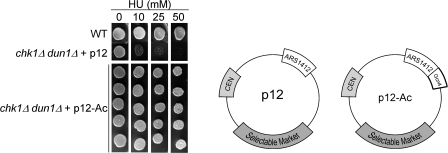Figure 5.
The timing of origin activation and of the episomal replication fork pause is critical to restore viability to chk1Δ dun1Δ cells. Targeting the acetylase Gcn5p–Gcn4p complex to the late activating origin ARS1412 restored the S-phase checkpoint in chk1D dun1D cells with constitutive expression of Gcn4p. Cells containing a high copy vector expressing Gcn4p and the indicated episomal origin were grown in SC-ura-leu media and spotted onto YPD medium containing the indicated concentration of HU (in millimoles). (bottom) Five representative chk1Δ dun1Δ transformants containing a high copy vector expressing Gcn4p and p12-Ac show results typical for 43/43 chk1Δ dun1Δ transformants containing the same constructs. p12, episome with late activating origin that failed to suppress chk1Δ dun1Δ; p12-Ac, same episome containing binding sites for the Gcn4p–Gcn5p acetylase complex.

